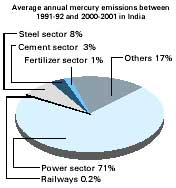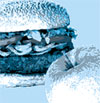Getting
away with
murder? |
 |
The
India’s industry continues to consume and emit mercury at alarming rates. Regulations
compare poorly to those in developed countries |
|
The Indian government has so far been unable to compile
any comprehensive data on all the uses of mercury in the country.There are some 3,000
industrial uses. Whatever little data is available on annual consumption is out of date.
But it is clear that the chlor-alkali industry, which manufactures caustic soda and
chlorine using the mercury cell process, is the single largest mercury consuming industry
in India, consuming about 70 tonnes of mercury each year. After the chlor-alkali industry,
the major consumption of mercury in India happens during the production of batteries,
thermostats, thermometers and barometers, and other electrical appliances such as mercury
vapour lamps, electrical switches and fluorescent lamps.
Some leading mercury users in India (1998-2001) |
| Sector |
Mercury (Hg) content per unit |
Number of units produced |
Total amount of mercury |
| Chlor-alkali1 |
About 200 gm mercury used per tonne of
caustic tonnes/year soda produced. All this mercury is passed on to the environment
through emissions and products. |
450,000 |
70 tonnes |
| Thermometers |
Varies between 0.6 to 1 gm. |
8957,0002 |
7.2 tonnes |
| Batteries |
• Alkaline Not more than 25 mg |
NA |
|
| • Mercury Zinc |
Total 33 to 50 per cent by weight of
the battery |
1,650 million3 |
25 tonnes5 |
| • Zinc Carbon |
Total 1per cent Hg by (LeClanche)
weight of the battery |
NA |
|
| Fluorescent lamps |
0.0252 to 0.080 gm / lamp6 |
150 million3 |
7.89 tonnes |
| Thermostat switches |
Between 3 gm to 6gm6 |
4051,0004 |
18.23 tonnes |
| Alarm clocks |
Average 0.6 or 0.7 gm per unit |
1481,0002 |
0.96 tonnes |
| Hearing aids |
0.4 gm per unit6 |
95,5003 |
0.04 tonnes |
Source: 1. Environmental Rating of
Indian Caustic-Chlorine Sector, Green Rating Project
(2002),Centre for Science and
Environment.
2. Industrial Handbook, Centre for Industrial & Economic Research (Delhi), 1998
3. Industrial Handbook, Centre for Industrial & Economic Research (Delhi), 2000-01
4. http://www.indiainfoline.com/auto/db01.html
5. Telephonic conversation with Battery Industry official
6. Draft Wisconsin Mercury Sourcebook, Wisconsin Department of Natural Resources
(USEPA grant), May 1997 |
| |
| Applications using mercury allowed
in India but banned or restricted in other countries |
| Catalytic
mercury compounds |
| Pesticides
(seed dressing) |
| Paints
(latex paints and possibly others) |
| Electrical
equipments, thermostats |
| Thermometers,
other measuring instruments |
| Biocides
in process industries |
| Source: Global Mercury Assessment, UNEP
Chemicals, Dec. 2002 |
As India does not produce any mercury, all of it has to be imported. About 170–190
tonnes of mercury were imported and consumed each year from 1998 to 2001. And this is
probably an underestimation as there is a thriving illegal trade in the commodity.
In developed countries, the use of mercury in various
products is either banned or regulated. No concrete initiative has however been taken by
the government of India to address the issue.
A draft notification was circulated by the Ministry of
Environment and Forest (MoEF) in 2000 for a phased elimination of mercury from consumer
products, but so far no action has been taken. The government is also dragging its feet on
the phasing out of existing mercury-based chlor-alkali plants. India is one of the very
few countries to allow the use of catalytic mercury compounds in industrial chemical
processes.
Total
annual mercury pollution in India
(Average between 1991-92 and 2000-2001) |
| Sources |
Mercury use
(tonnes/annum) |
Mercury released
(tonnes/annum) |
| Chlor-alkali Industry |
70 |
70 |
| Other mercury containing products |
100 |
27.5–55 |
Unintentional mercury release
due to coal use |
Nil * |
75 |
| Total |
170 |
172.5–200 |
Source: GRP, CSE.
* On an average, about .25ppm of mercury is present in Indian coal |
Unintentional mercury releases
The mercury content in coal found in India ranges between 0.01 parts per million (ppm) to
1.1 ppm. A typical power plant emits 90 per cent of its mercury into the air and 10 per
cent to land. The main reason for such a high rate of emission is that mercury boils at
low temperatures. Assuming the average mercury content in coal found in India to be 0.25
ppm, about 65 tonnes of mercury has been released every year between 1991–92 and
2000–2001 into the environment due to coal consumption alone, of which about 45.5
tonnes comes from thermal power plants.
End-of-pipe treatment technologies can effectively
control this unintentional release. Unfortunately, the issue of unintentional release of
mercury has not even been identified by the government as an environmental problem and
therefore no initiatives have been taken to reduce the risks.
Total mercury pollution
From the estimations done by CSE’s Green Rating Project, the potential release of
mercury into India’s environment could currently be anywhere between 172.5 – 200
tonnes every year, and these figures exclude releases from other fossil fuels. This amount
represents a grave danger for the country.
| Battery attack:
household batteries may contain large amounts of mercury |
 |
Estimation Methodology
Considering that the 11 mercury cell plants alone consume about 70 tonnes of mercury,
at least 70 tonnes out of the total of 180 tonnes of mercury imported annually in India is
immediately released into environment.
Besides, mercury is used in various products like
clinical thermometers, medical instruments, fluorescent tubes, switches, electrical
thermostats, batteries, pesticides, traditional Indian drugs and certain pharmaceutical
and agricultural products. On an average, about 100 tonnes of mercury is consumed in these
products. A majority of these products have a short life span and the mercury used in them
quickly finds its way into the environment once the product has served its purpose. Here
are two possible scenarios:
| Unintentional
release due to local consumptin |
 |
| Source: Estimated by GRP, CSE |
Scenario 1: If only
25 per cent of these products have a shelf-life of less than a year, then 27.5 tonnes of
mercury would be released into the environment from them annually. Add to that the
additional mercury burden from coal use and the chlor-alkali industry, and the total
annual release of mercury is 172.5 tonnes.
Scenario 2: If only
50 per cent of these products have a shelf-life of less than a year, then 55 tonnes
mercury would be released each year into the environment from these products alone. Add to
that the additional mercury burden from coal use and chlor-alkali industry, and the total
annual release of mercury is 200 tonnes.
The problem assumes menacing proportions once we consider
the fact that
mercury is highly mobile and travels far and wide. It represents a grave danger even for
populations that have no major mercury polluting sources nearby.
| Government
initiatives and regulations to control mercury pollution (India compared to some other
countries) |
|
|
 |
PRODUCTS
AND PROCESSES |
India
Still trying to bring about a legislation for phased elimination of mercury from consumer
products such as thermometers, fluorescent tubes, batteries, electrical thermostats and
switches, medical instruments and certain pharmaceutical and agricultural products with an
exemption for essential products.
New mercury-based chlor-alkali plants have been banned, but the old ones are still allowed
to operate.
China
Chlor-alkali plants: New
mercury-based plants banned, few existing.
Batteries:
mercury permitted at 0.025 per cent by weight (till 2004), 0.0001 per cent by weight for
alkaline
manganese type (from 2005).
Cosmetics: 1 mg/kg.
European Community
Chlor-alkali plants: New
ones banned, strict emission norms, total phasse-out by 2010.
Batteries and accumulators: 0.0005 per
cent by weight
Button cells: Two per cent
by weight, collection and safe disposal of spent batteries and accumulators.
Electrical and electronic equipment: Substitution
of mercury by 2008.
Packaging: Sum of lead,
cadmium, mercury and hexavalent chromium: 100 mg/kg
Pesticides: Ingredients
banned: Mercury oxide, mercurous chloride, other inorganic mercury compounds, alkyl
mercury compounds, alkoxyalkyl and aryl mercury compounds.
Vehicles: Vehicle
components released in the market after 1 July 2003 shall not contain mercury.
Marketing and use: Mercury
compounds may not be used as substances and constituents of preparations in the following:
a. Hulls of boats, cages, floats, nets and any other
appliances or equipment used for fish or shell-fish farming;
b. Any totally or partly submerged appliances or equipment;
c. The preservation of wood;
d. The impregnation of heavy-duty industrial textiles and yarn intended for their
manufacture; and
e. In the treatment of industrial waters, irrespective of their use.
Import and export: Mercury oxide, mercurous chloride,
other inorganic mercury compounds, alkyl mercury compounds, alkoxyalkyl and aryl mercury
compounds are banned or restricted.
Japan
Chlor-alkali plants: Banned
completely.
Batteries: Production of mercuric
oxide batteries stopped in 1994.
Paints: Must not
contain organomercury compounds.
Pesticides: No pesticide
containing mercury, including pesticide for
seed dressing, has been registered since 1973.
Household products: Organic
mercury compounds must not be detected in any product.
 |
WASTE |
India
Compost: 0.15 mg/kg in dry basis
discharge.
Industrial effluents: 0.01 mg/l.
Treated leachate: 0.01
mg/l (land, water and sewers).
Chlor-alkali industry:
From hydrogen gas holder stack: 0.2 mg/Nm3 Waste water generation: 10 kl / tonne
caustic soda produced, pH 5.5 to 9.0 No more new caustic soda plants based on the mercury
cell process will be allowed.
China
Wastewater point sources: 0.05
mg/l.
Air emission point sources: Maximum
discharge concentration of 0.015 mg/m3–0.012mg/m3.
Waste treatment, including incineration: 0.2 mg/m3.
Japan
Drain water and effluents: 0.005
mg/l total mercury. Alkyl mercury must not be detected.
Chlor-alkali industry: Stopped
using mercury since 1984.
 |
FOOD, WATER, AIR
and SOIL |
India
Foodstuff: Vegetables:
0.5 mg/kg,
Milk: 0.003 mg/l,
Fish: 0.5 mg/kg.
Drinking water:
0.001 mg/l.
China
Residential ambient air: 0.0003 mg/m3 (daily average).
Sea water: 0.0005 mg/l–0.0002 mg/l.
Surface water: 0.00005 mg/l–0.001 mg/l.
Ground water: 0.00005 mg/l–0.001 mg/l.
Drinking water:
< 0.001 mg/l, irrigation water: 0.001 mg/l.
Fisheries: 0.0005
mg/l.
Soil: 0.15 mg/kg -
1.5 mg/kg.
EUROPEAN COMMUNITY
Foodstuffs: Fish: 0.5 mg/kg–1.0
mg/kg.
Drinking water:
0.001 mg/l.
Japan
Fish: 0.4
mg/kg total mercury, 0.3 mg/kg methyl mercury
Water: 0.0005 mg/l
total mercury, alkyl mercury must not be detected. Alkyl mercury compounds: 0.01 mg/m3.
Soil: 0.0005 mg/l
total mercury, no alkyl mercury. |
|






